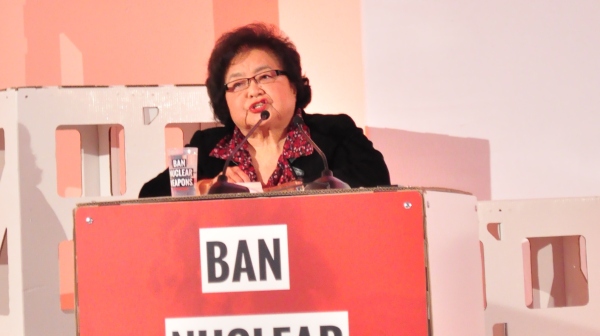These were the dramatic words of Dr. Ira Helfand in the opening panel of the civil society forum organised by the International Campaign Against Nuclear Weapons, in Vienna, Austria, today.
The forum, bringing together 600 activists, youth and experts from 70 countries, has been organised in the run up to the inter-governmental conference on the humanitarian impacts of nuclear weapons organised by the Austrian Government with the participation of over 150 countries on the 8th and 9th of December.
Today’s opening panel with the title “Nuclear Weapons – Why do we care?” was preceded by the harrowing and dramatic testimony of a bomb survivor from Hiroshima.
As a 13-year old school girl, Setsuko Thurlow and her friends from school were being trained on how to crack codes and secret messages in a facility on the outskirts of Hiroshima when she saw a blinding light and had the sensation of floating in the air. When she regained consciousness she found herself pinned under building rubble and with the help of others also trapped she was able to crawl out with two of her school friends.
What they saw left them stunned; figures, barely human, approaching them, some with intestines and eyeballs hanging outside of their bodies, burned skin and hair standing on end, walking skeletons and half dead people.
Walking over bodies, the girls made their way to the hills looking for water and helping other survivors as best they could. With no cups or buckets for transporting water all they could do was soak their blouses in water and pass it round for people to suck on.
Setsuko vividly described the experience, leaving the audience stunned and deeply moved. She outlined what happened in the days after; the people dying, the family members lost, the friends incinerated, the 351 classmates whose lives were so cruelly cut short.
She explained how the Americans arrived but instead of bringing medical assistance they brought researchers to monitor the effects of the radiation on the victims. Japanese doctors, unequipped and untrained for such a disaster had no way to respond.
Barely able to hold back her own emotion recounting a story that she has surely told around the world countless times, she forces herself in what must be a personal torture for her to repeat her testimony once more in the hope that it makes a difference and ensures that a nuclear bomb will never be used ever again.
At the end of the presentation a long, yellow banner was held up with the names in Japanese of the school friends lost on the 6th August 1945, almost 70 years ago.
“Here are 351 schoolmates of mine and I can remember their faces. I have a deep memory of each one. I want you to remember that each one of them had a life, had a name… We are concerned about the humanitarian impact of nuclear weapons. Until now we have been talking about ‘deterrence’ and ‘balance of power’ and all these things. I am relieved finally that we are now talking about human beings about what nuclear weapons do to human beings. All these friends of mine are gone, they are wiped out from the face of the planet. This is something we want to prevent. We have to ban all these weapons, these evil bombs, all 17000 of them.”
In the light of such testimony it is incredible to imagine that these bombs still exist 69 years after their first use. The organisers of this forum and the inter-governmental conference hope that such powerful stories as this one and those of the survivors of the test bombs on Bikini Atoll and in Kazakhstan will turn the table on the discussions about nuclear weapons, focusing on the impacts on human beings and making it a moral imperative to disarm as soon as humanly possible.










